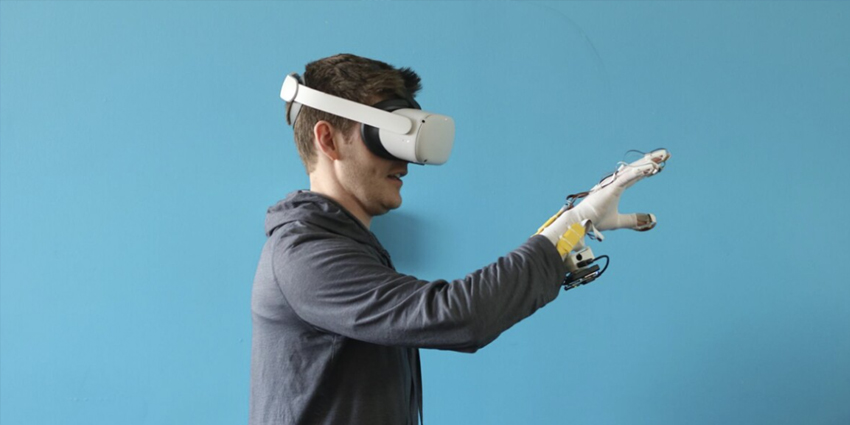This week, Fluid Reality debuted a haptic glove solution, which introduces a range of competitive features to the fledging XR accessories marketplace that sees haptic glove solutions present benefits in healthcare, automation, and training use cases – despite the haptic market appearing somewhat dormant in 2023.
The firm’s new haptic glove product notably features untethered usability, meaning that the product does not need to be physically wired to an additional computing device – significantly increasing the portability and usability of haptic gloves, opening a world of new opportunities for enterprise clients.
Moreover, the device boasts 160 dynamic haptic feedback actuators that apply pressure to a user’s fingertips to replicate touch. Fluid Reality’s solution provides touch simulation via advanced built-in “fluid bubbes” at the operator’s fingertips that allow them to feel a virtual “complex contact geometry, texture, and compliance, as well as expressive spatiotemporal effects,” according to a research paper published by the firm.
Moreover, in the firm’s research paper, Fluid Reality interestingly noted how, while there are many innovations in immersive audio and visuals, interest in haptic immersion remains low. The firm explained:
Virtual and augmented reality headsets are making significant progress in audio-visual immersion and consumer adoption. However, their haptic immersion remains low, due in part to the limitations of vibrotactile actuators which dominate the AR/VR market.
Fluid Reality is a subsidiary of Future Interfaces Group at Carnegie Mellon University, whereby the spin-off is looking to leverage its findings to provide enterprise and consumer XR solutions.
The device is much lighter than competitive devices. The Fluid Reality product weighs o.2KG. On the other hand, competing emerging devices weigh roughly 30kg [HaptX DK2], 25 kg [Meta Haptic Glove], and 17 kg [HaptX G1]. Additionally, the device boasts other competitive features compared to other companies, such as a lower cost and higher touch feedback resolution.
Haptics and the Future of Input
Fluid Reality’s device works alongside hand-tracking solutions to continue innovations stride in XR headset input. The incredibly lightweight device, unlike competitors, could enable end-users to feel more immersed within a VR application without a bulky kit holding that feeling back.
Notably, in its demonstration video, Fluid Reality showcased how the device is compatible with HTC VIVE hand-tracking products and the Meta Quest 2/3’s built-in hand-tracking features.
Alongside a lightweight design, the device’s interoperability also helps improve the usability of VR in enterprises by giving IT teams more freedom in distributing company-wide XR devices.
Utilizing haptic glove solutions presents many pain points, particularly in the enterprise. Already, XR devices are cumbersome by design, and many individuals would rather not have a bulky headset on; with an added haptic device and more weight, scaling enterprise XR adoption will prove difficult.
However, thanks to Fluid Reality’s lightweight design, introducing workers and decision-makers to haptics-ready XR may become more manageable. Moreover, mixed with the ever-decreasing size and weight of XR wearables across the market, innovations in haptic glove design may present new opportunities to a range of end users.
A Quiet but Valuable Market
Despite the potential held by the haptic glove market and growing investments into XR generally, haptic glove development is somewhat dormant.
Despite industry champions like HaptX and Senseglove innovating in the space, eyes are diverted away from haptics – for the time being.
Moreover, enterprise end-users such as Honda, Scania, and Volkswagen are all experimenting with haptic gloves in the workplace. However, big firms like Meta are seemingly pausing research into the space instead of other lucrative emerging tech markets.
However, Meta might not be out of the haptic glove market yet; the firm is constantly investing in its Realtiy Labs division, and there may be more developments behind the scenes. The XR leaders acquired haptic device start-up Lofelt in 2022 as it was working on new Quest products.
2024 is looking to be a big year for XR, with many technology innovations coming soon, but will haptic gloves play a part in this future and continue to reserve investment?







